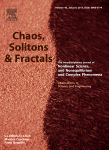
CHAOS SOLITONS & FRACTALS
Scope & Guideline
Illuminating the Complexities of Mathematical Physics
Introduction
Aims and Scopes
- Nonlinear Dynamics and Chaos Theory:
The journal covers fundamental theories and models related to nonlinear dynamics, including chaos theory, bifurcation analysis, and the study of complex systems. - Solitons and Wave Phenomena:
Research on soliton dynamics, including the development of new soliton solutions and their applications in various media, is a significant focus area. - Fractal Analysis and Applications:
Papers often explore fractal geometry and its applications in modeling natural phenomena, providing insights into complex patterns and structures. - Mathematical Modeling of Biological Systems:
The journal publishes studies on mathematical models that describe biological processes, including epidemic models, population dynamics, and ecological interactions. - Computational Methods and Simulations:
There is a strong emphasis on computational techniques, including numerical simulations, machine learning, and optimization methods applied to chaotic systems and nonlinear dynamics. - Interdisciplinary Applications:
The journal encourages submissions that bridge multiple disciplines, applying chaos theory and fractal analysis to fields such as finance, engineering, and environmental science.
Trending and Emerging
- Machine Learning and AI Applications:
There is a growing trend of integrating machine learning techniques with chaos theory and nonlinear dynamics, particularly for predictive modeling and data analysis in various fields. - Complex Networks and Systems:
Research focusing on complex networks, including social networks and biological systems, is increasingly prominent, exploring how network structure influences dynamics. - Fractional Calculus and Nonlocal Models:
The application of fractional calculus to model complex systems with memory effects is gaining traction, reflecting a shift towards more sophisticated mathematical frameworks. - Epidemiological Modeling:
With the ongoing global health challenges, there is a significant increase in studies modeling infectious disease spread, particularly COVID-19, highlighting the importance of dynamic modeling. - Sustainable and Ecological Dynamics:
There is a rise in research addressing ecological and environmental dynamics, particularly in the context of sustainability and resource management. - Multiscale and Multidimensional Analysis:
Emerging interest in multiscale modeling and analysis techniques for understanding chaotic behavior across different spatial and temporal scales is evident.
Declining or Waning
- Classical Linear Dynamics:
Research focusing solely on classical linear systems appears to be declining, as more studies integrate nonlinear dynamics and chaos. - Basic Theoretical Models without Application:
Papers that present theoretical models without practical applications or interdisciplinary relevance are becoming less common, with a shift towards more applied research. - Overly Specialized Topics:
Niche topics that do not connect broadly with other fields or applications may be waning, as the journal favors research with wider implications and interdisciplinary links. - Traditional Mathematical Methods:
There is a noticeable decrease in the use of traditional mathematical techniques in favor of innovative computational methods and machine learning applications.
Similar Journals
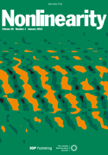
NONLINEARITY
Bridging Disciplines Through Nonlinear ExplorationNONLINEARITY is a premier academic journal published by IOP Publishing Ltd, dedicated to advancing the field of complex systems through the lens of nonlinear science. Since its inception in 1988, the journal has established itself as a vital resource for researchers and professionals alike, offering a robust platform for disseminating high-quality research in areas such as applied mathematics, mathematical physics, and statistical and nonlinear physics. With an impressive Q1 ranking across multiple pertinent categories, including Applied Mathematics and Mathematical Physics, NONLINEARITY ranks among the top journals globally, making it essential reading for those seeking to deepen their understanding of nonlinear phenomena. Although it does not operate under an open-access model, its rich repository of rigorous articles significantly contributes to academia, fostering innovative thought and facilitating cutting-edge research. Located in the heart of the United Kingdom at TEMPLE CIRCUS, TEMPLE WAY, BRISTOL BS1 6BE, NONLINEARITY continues to be at the forefront of the scientific community, championing new discoveries and interdisciplinary dialogue within its dynamic scope.
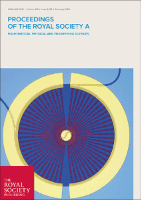
PROCEEDINGS OF THE ROYAL SOCIETY A-MATHEMATICAL PHYSICAL AND ENGINEERING SCIENCES
Exploring Innovative Research for a Scientific Tomorrow.PROCEEDINGS OF THE ROYAL SOCIETY A-MATHEMATICAL PHYSICAL AND ENGINEERING SCIENCES is a prestigious academic journal published by the Royal Society in the United Kingdom, dedicated to the dissemination of high-quality research in the fields of Mathematics, Engineering, and Physics. With an esteemed impact factor and ranked in the top quartiles (Q1) across various categories, this journal stands out as a leading source of innovative findings and critical discussions within the global scientific community. Researchers benefit from its comprehensive coverage that spans from theoretical explorations to practical applications, and the journal plays a crucial role in advancing knowledge and fostering interdisciplinary collaboration. Although it does not currently offer Open Access options, its influence is underscored by notable Scopus rankings, evidencing its significant contribution to the fields it represents. Located at 6-9 Carlton House Terrace, London SW1Y 5AG, England, the journal continues to be a cornerstone for scholars seeking to publish impactful research and stay informed on the latest advancements in science and engineering.

JSIAM Letters
Connecting Researchers and Practitioners in MathematicsJSIAM Letters, with ISSN 1883-0609 and E-ISSN 1883-0617, is an esteemed journal published by the Japan Society of Industrial and Applied Mathematics (JSIAM). Focusing on the latest advancements in the field of industrial and applied mathematics, this journal serves as a vital platform for researchers, professionals, and students to disseminate their findings and exchange innovative ideas. Although it currently does not offer Open Access options, JSIAM Letters maintains a strong reputation for high-quality, peer-reviewed articles that contribute to the growth and application of mathematical techniques in various industrial contexts. With a commitment to fostering collaboration within the mathematical community, JSIAM Letters plays a crucial role in bridging the gap between theoretical research and practical application, making it indispensable for anyone interested in the intersection of math and industry.

Journal of Dynamical Systems and Geometric Theories
Fostering Insightful Discourse in Geometric TheoriesJournal of Dynamical Systems and Geometric Theories, published by TARU Publications, is a prominent platform dedicated to advancing knowledge in the fields of dynamical systems and geometric theories. With an ISSN of 1726-037X and an E-ISSN of 2169-0057, this journal serves as a vital resource for researchers, professionals, and students who are keen on exploring the complexities of mathematical models and their applications in various scientific disciplines. Though currently listed as non-open access, the journal provides robust, peer-reviewed content that is essential for fostering innovative research and development. Situated in New Delhi, India, the Journal of Dynamical Systems and Geometric Theories is committed to disseminating high-quality scholarly articles that address both theoretical and practical issues related to dynamical systems, enhancing understanding and stimulating further academic discourse. To learn more about submission guidelines and access options, please visit the journal’s official webpage.
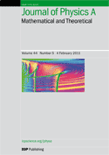
Journal of Physics A-Mathematical and Theoretical
Innovating Theoretical Insights for Tomorrow's DiscoveriesThe Journal of Physics A-Mathematical and Theoretical, published by IOP Publishing Ltd, is a premier peer-reviewed journal dedicated to advancing the understanding of mathematical physics, modeling, and simulation methods within the dynamic field of physics and astronomy. Established in the United Kingdom, this journal has made significant contributions over the years, maintaining a strong reputation as a Q1 and Q2 ranked journal across various categories, reflecting its influence in the scientific community. With a focus on innovative and theoretical approaches, it provides a platform for researchers, professionals, and students to disseminate their findings and engage with groundbreaking methodologies. Despite its lack of open access options, the journal's high impact factor and Scopus rankings, which place it in the top percentiles across multiple disciplines, underscore its critical role in fostering scholarly communication and collaboration in mathematical and theoretical physics. As we move through its converged years from 2007 to 2024, the Journal of Physics A continues to be a pivotal contributor to the landscape of contemporary physics, stimulating discussions and advancing knowledge in an ever-evolving realm.
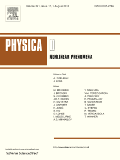
PHYSICA D-NONLINEAR PHENOMENA
Pioneering Research in Nonlinear Dynamics Since 1980PHYSICA D-NONLINEAR PHENOMENA, published by Elsevier, serves as a leading academic journal at the forefront of the fields of Applied Mathematics, Condensed Matter Physics, Mathematical Physics, and Statistical and Nonlinear Physics. With an impressive track record since its inception in 1980, this journal has maintained a distinguished presence, noted for its Q1 ranking in multiple categories in 2023, showcasing its impact and relevance in the scientific community. The journal's commitment to advancing knowledge is reflected not only in its rigorous peer-reviewed articles but also through its high visibility and accessibility, aiding researchers, professionals, and students in staying abreast of the latest developments in nonlinear phenomena. Located in Amsterdam, Netherlands, PHYSICA D-NONLINEAR PHENOMENA is essential for those seeking to explore innovative research and contribute to groundbreaking discoveries in the realm of nonlinear dynamics.

JOURNAL OF DYNAMICAL AND CONTROL SYSTEMS
Exploring Innovative Solutions in Dynamic InteractionsJOURNAL OF DYNAMICAL AND CONTROL SYSTEMS is a premier interdisciplinary journal published by Springer/Plenum Publishers, recognized for its significant contributions to the fields of dynamical systems, control theory, and numerical analysis. With an ISSN of 1079-2724 and an E-ISSN of 1573-8698, the journal serves as an important platform for researchers and professionals to share their findings and innovative methodologies. Covering topics from algebra and number theory to control and optimization, it holds a respectable position in the 2023 Q2 quartile rankings across various categories, reflecting its impact and quality within the academic community. The journal’s scope is expansive, aiming to foster advancements and insights that are instrumental for academics and industry experts alike. With a convergence period from 1995 to 2024, the journal continues to be a vital resource for students, researchers, and professionals seeking to navigate the complexities of control systems and their dynamic interactions. For those looking to contribute to the ongoing discourse in these critical areas of study, the JOURNAL OF DYNAMICAL AND CONTROL SYSTEMS remains a highly recommended choice.

Journal of Fractal Geometry
Unraveling the Beauty of Fractal StructuresWelcome to the Journal of Fractal Geometry, an esteemed publication in the fields of Applied Mathematics and Geometry, proudly published by the European Mathematical Society (EMS). With its open access model initiated in 2021, the journal ensures that groundbreaking research is readily available to scholars all around the globe. Since its inception, the journal has positioned itself as a vital platform for the dissemination of innovative research, focusing on the intricate study of fractal structures and their applications in various scientific domains. With an impressive H-index reflecting the journal's influence, it holds high rankings in respected databases, specifically ranking in the Q1 and Q2 quartiles for its authoritative contributions in applied mathematics as well as geometry and topology. Located in Berlin, Germany, the journal is dedicated to fostering a vibrant community of researchers, professionals, and students engaged in the beauty and complexity of fractals, making it an essential resource for advancing knowledge in this dynamic area of study.
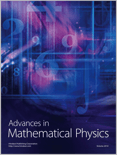
Advances in Mathematical Physics
Shaping the Future of Interdisciplinary ScienceAdvances in Mathematical Physics is a premier open-access journal published by HINDAWI LTD, dedicated to the dissemination of research in the fields of applied mathematics and physics. With its ISSN 1687-9120 and E-ISSN 1687-9139, this journal has been a vital platform for innovative studies since its inception in 2009, fostering a collaborative environment for researchers and professionals alike. The journal features a wide range of topics, including but not limited to mathematical models, computational physics, and interdisciplinary applications, thus attracting a diverse readership. Ranked in the Q3 quartile for both Applied Mathematics and Physics and Astronomy, it serves as a significant resource for academics looking to explore cutting-edge developments and theoretical advancements. With an emphasis on open accessibility, Advances in Mathematical Physics ensures that research findings are readily available to the global academic community, leveling the playing field for emerging scholars and seasoned researchers. By consistently showcasing high-quality manuscripts, the journal contributes substantially to the fields of mathematics and physics, encouraging scholarly dialogue and advancing knowledge across a myriad of applications.

REGULAR & CHAOTIC DYNAMICS
Elevating the Study of Non-Linear DynamicsRegular & Chaotic Dynamics, published by PLEIADES PUBLISHING INC, is an esteemed journal that serves as a vital platform for disseminating cutting-edge research in the fields of applied mathematics, mathematical physics, and various interdisciplinary realms. With its ISSN 1560-3547 and E-ISSN 1468-4845, the journal features a diverse array of articles that delve into the dynamic systems and the intricacies of non-linear phenomena, offering insights invaluable to researchers and professionals alike. Since its launch in 1998, it has established itself as a significant resource, holding impressive rankings in Scopus that highlight its influence, including Q2 and Q3 quartile designations across multiple categories. While the journal is not open access, its rigorous peer-review process ensures high-quality publications that advance the discourse within the scientific community, making it an essential read for scholars dedicated to exploring the complexities of dynamical systems.